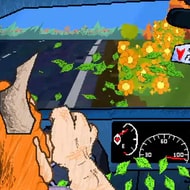

Bergentruck 201x is a rhythm-driven driving game that transforms a single piece of iconic music into an entire interactive experience. Based on the unforgettable “Bergentruckung 2010” battle theme from the Deltarune universe, this game reimagines driving as a cinematic, audio-reactive journey.
Instead of focusing on speed or lap times, the gameplay is structured around musical timing, visual immersion, and beat synchronization. As the music intensifies, so does the road — the environment pulses, warps, and shifts in direct response to the soundtrack’s structure, creating a hypnotic fusion of sound and motion.
At its core, Bergentruck 201x is about harmony between sound and movement. The player is placed behind the wheel of a stylized vehicle, driving through endless digital landscapes that morph and shift in response to the music. Unlike typical racing games, this title doesn’t rely on opponents or finish lines.
Instead, it challenges players to stay on the rhythm, avoid sudden tempo-triggered obstacles, and maintain control during dynamically changing sequences. The game rewards precision and instinct, turning each drive into a dance between player and soundtrack.
The audio in Bergentruck 201x isn’t background — it’s the foundation. Every visual cue, obstacle, and directional shift is built around the beat. The game uses a layered version of the original Bergentruck track, featuring moments of silence, distortion, and intensity spikes. Players are forced to react not just visually, but aurally. Listening closely becomes essential for survival and progression, making each playthrough a deeply sensory experience.
Rather than awarding points or wins, the game encourages flow. The reward is the sense of unity between player, road, and rhythm. It’s a meditative experience with moments of intensity, designed to make each player feel as though they’re part of the soundtrack itself. This makes Bergentruck 201x less of a traditional game and more of a playable visual album built around a single iconic theme. The absence of traditional scoring removes pressure, replacing it with pure synchronization and immersion.